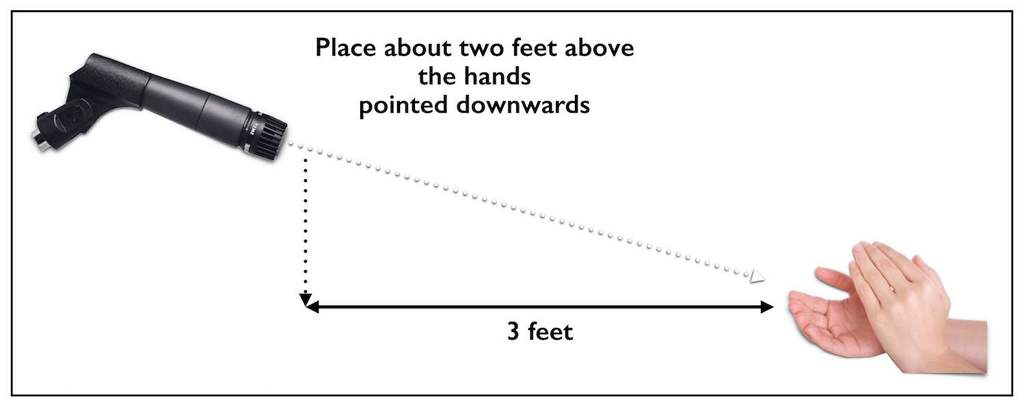- in Engineering by Bobby Owsinski
5 Techniques For Recording Great Handclaps

It’s surprising how often handclaps are used, either as an enhancement to the backbeat or as a standalone mix element. That said, getting a great clap sound can be elusive, as the huge effect that everyone expects is more difficult to achieve than you might expect.
Here are 5 techniques that you can use for recording handclaps, along with a number of useful tips for making them sound bigger than life.
Placements
First of all remember that the sound of the room plays a big part in the sound. The larger the room is and the better it sounds, the less work will be required to make them sound larger than life.
Technique #1: Claps need distance to develop, so start with a dynamic mic (to smooth out the transients) at least 3 feet away (see the graphic below). Place the mic a couple of feet above the clappers and point it down in order to eliminate air bursts from the hands.

Technique #2: Use a mic with a figure-8 pattern to avoid any slap echo from the floor or ceiling. You have to change the position of the microphone from above the clappers to on line with them for this to work. This also has the advantage of picking up more room from the back side of the mic, which could be an advantage in a good room, or something to avoid if it isn’t.
Technique #3: Mix in someone clapping two pieces of wood together (instead of their hands) with the real handclaps (a classic old-school trick). This is provide an edge to the sound that’s probably missing from using only fleshy hands.
Technique #4: Space the clappers a couple of feet apart distance-wise from the mic. Five people works well. Have the folks nearest the mic clap more on top of the beat and the folks farther away clap more laid back. Split the claps between two styles: sharp slap-clap done by slapping the fingers of one hand into the palm, and a deeper, more standard palm clap done by clapping both palms together. The distance and timing variation gives a nice thick, cascading effect.
Technique #5: Try having the clappers sit and slap their thighs. You get twice as many claps and a somewhat darker, more full-bodied timbre, but not as much edge or definition.
Useful Handclaps Considerations
- Claps are best done in a group, and the more clappers the better. Claps are often augmented with foot stomps, boards, or electronic claps to achieve the proper effect.
- Double-tracking the claps makes them sound far bigger. Make sure that the clappers take a step back from the mic for the second take in order to capture more room sound (this will make them sound even bigger).
- Use a fairly live room, back the mike away from the clappers, and use a compressor that has variable attack and release times. Compress heavily (10 to 20dB of gain reduction) at a fast to medium attack time so that there’s not too much attack. Set the release time fairly fast, but play with making it longer for more body.
- Gating (but not too tightly) will help keep the track clean. If you need an “ultra-tight to the snare” sound, key the gate from the snare drum.
- As with other percussion instruments, the peaks are always 10 to 15dB greater than what a typical VU meter is reading (if you happen to be using one). Therefore, it’s best to record the signal at about -20 VU or so, or around -10dbFS on a normal DAW peak meter.
You can read more from The Recording Engineer’s Handbook and my other books on the excerpt section of bobbyowsinski.com.

